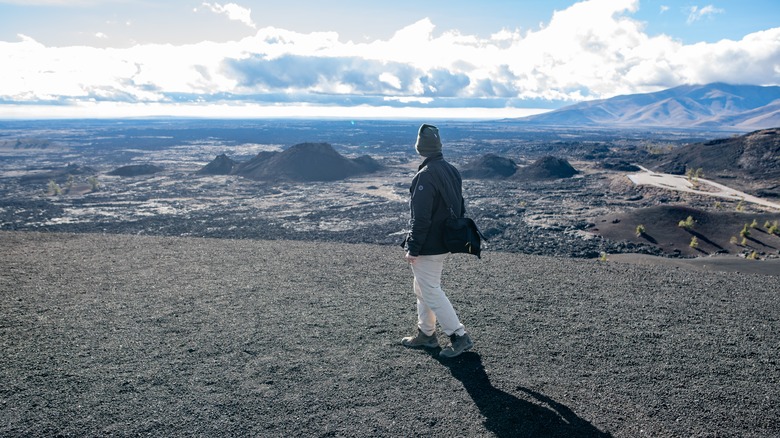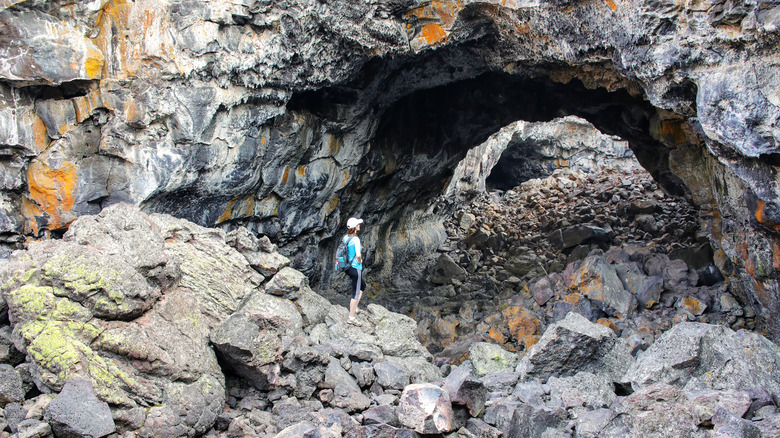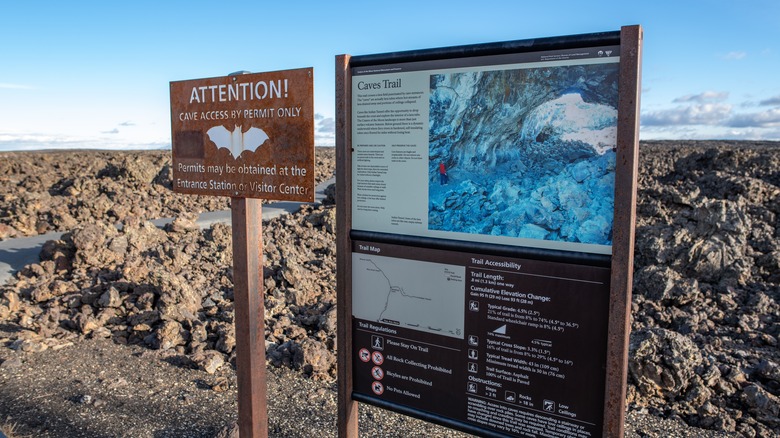The Unique US National Park That Makes You Feel Like You've Stepped Onto The Moon
The intrigue of space travel can certainly be a strong pull on adventurers. In this day and age, more tourists than ever before have opportunities to access the cosmos for the right price. Private space enterprises like Blue Origin, Space Perspective, and SpaceX have made space tourism a tangible concept in recent years. Future Market Insights reports that space tourism market revenue is expected to reach over $678 million by the end of 2023.
For travelers who are inherently fascinated by space but prefer to keep their feet on planet Earth, opportunities to experience the surface of the moon aren't out of reach. Setting your sights on destinations like Craters of the Moon National Monument and Preserve in Idaho is a great example of how to make it happen. A trip here can transport you to galactic-inspired aesthetics without ever leaving the atmosphere.
Many tourists who visit Craters of the Moon are stunned — with good reason — by the destination's uncanny lunar resemblance. The culmination of vast lava fields, loose rocks, and craters paired with a unique lack of plant life creates the distinct feeling you've left the world you know far behind. Top it off with somber landscape hues showcasing cinder-black just about everywhere you look, and the surface of the moon simply doesn't feel that far away.
A lunar-inspired landscape crafted over millennia
Many Idaho-bound adventurers inevitably head to Yellowstone National Park during their stay to experience captivating geysers, wildlife, and hot springs alike. However, making your way toward Craters of the Moon is an equally majestic experience. The otherworldly geology you can observe and explore here is believed to have come together over 15,000 years ago as the surface of the earth experienced no less than eight eruptive volcanic periods.
If you begin your Craters of the Moon stop at the visitor center, you'll find yourself within reach of a series of dynamic cracks in the earth known as the Great Rift. This is where experts believe early lava eruptions began that eventually formed over 618 square miles of this lunar-inspired lava field terrain. Iconic Craters of the Moon stops like the Kings Bowl lava field and the Wapi lava field are believed to have formed along the same Great Rift as recently as 2,000 years ago during dramatic eruptions.
Craters of the Moon National Monument and Preserve so closely resembles the surface of the moon that astronauts have been known to train for their upcoming missions here. In 1969, Apollo 14 astronauts were sent to the region to explore the lava-rich landscape as a way to prepare for collecting lunar samples on their galactic missions. Astronauts Joe Engle, Eugene Cernan, and Edgar Mitchell returned once again to Craters of the Moon in 1999 to celebrate the monument's 75th anniversary and pay homage to their preparation site.
How to explore Craters of the Moon
Beyond the miles of blackened earth and craters, a visit to Craters of the Moon is a chance to explore the home to an impressive system of lava tubes below ground. The appeal is irresistible among avid cavers.
Visitors also have access to 25 cinder cones on-site and no less than 60 lava flows to add to their must-visit list. A good way to pick and choose your stops here is to pick up a map at the visitor center, where you can also enjoy an information park film before setting out. The 7-mile Loop Road is a popular starting point at the monument thanks to the fact it links up with many of the largest caves and most traveled area trails. If you have an entire day to spare here, rangers often recommend spending time in the wilderness area and hiking the Wilderness Trail, which offers up some of the most breathtaking views.
As with all visits to National Parks and monuments, it's important to keep sustainable tourism approaches in mind to maintain the integrity of the landscape for generations to come. Travelers to Craters of the Moon are prohibited from off-trail travel in certain regions — the North Crater Flow and Spatter Cones/Big Craters — to protect fragile rock formations that are thousands of years old. You'll also need to pick up a free cave permit if you're venturing into lava tubes that are in place to protect bat species that call the caves home. These are easily obtained at the visitor center.


